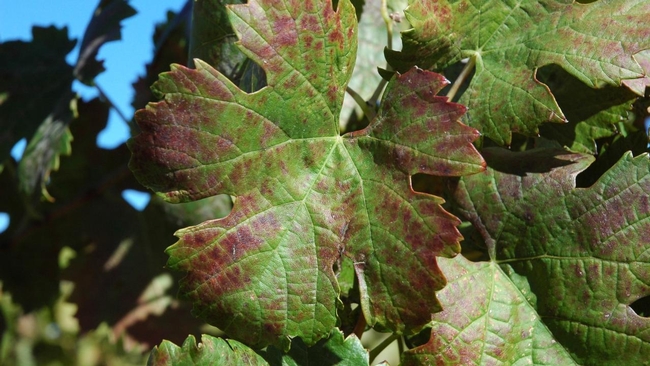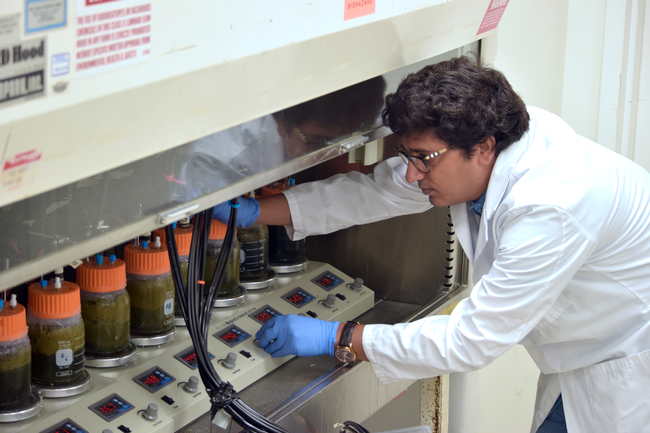Posts Tagged: greenhouse
UC Davis to build new $5.25M greenhouse to protect U.S. grapevine collection
Project designed to prevent red blotch and other grapevine diseases
A new, $5.25 million greenhouse is being built on the University of California, Davis, campus to safeguard an important grapevine collection from red blotch disease and other pathogens.
The 14,400-square-foot greenhouse will have a vestibuled entry, be insect-proof and provide another level of disease protection. It is being spearheaded by Foundation Plant Services, or FPS, which provides the U.S. grape industry with high-quality, virus-tested grapevine plant material.
The program serves as the primary source for grapevine plant material distributed to nurseries under the California Department of Agriculture's Grapevine Registration and Certification Program, which provides the majority of grapevines planted in the United States. For the grape industry, it is essential to protect this material from disease-carrying insects and guarantee fast access to clean plant material.
“The program is considered the largest quarantine center for the grapevine industry in the United States,” said Maher Al Rwahnih, a plant pathologist and FPS director. “This is kind of a game changer for us.”
A history of serving the grapevine industry
FPS has maintained healthy grapevine planting stock on the UC Davis campus for more than 70 years in open fields at the Classic and Russell Ranch foundation vineyards. FPS scientists first detected grapevine red blotch virus at Russell Ranch in 2017. By 2021, an estimated 51.6% of the crop there was infected. Material from that vineyard is not being sold, and the site is now part of an epidemiological study to try to pinpoint how the disease is transmitted.
FPS pathologists have detected red blotch on less than 1% of the Classic vineyard crop. But it may not always be that way in the future.
“We don't know how long the Classic vineyard will remain clean,” Al Rwahnih said. “Every testing season, this is what keeps me up at night. We're not sure why it's happening in Russell Ranch and not the Classic vineyard.”
Once the greenhouse is operating, grapevines propagated from plant material from the Classic vineyard will be moved into the greenhouse, tested and verified as clean from disease. From there it will be sold to nurseries, which will grow additional plants to sell to growers.
Two greenhouses part of plan
Normally the foundation has 4,000 vines available, but the greenhouse will only house 2,000 vines, so inventory will be cut in half.
“This phase is just a starting phase,” Al Rwahnih said. “It's not sufficient for our needs.”
FPS plans to build another greenhouse in the next two to three years to increase capacity.
Industry groups and FPS identified greenhouses as the best way to protect the plants from red blotch and other pathogens transmitted by insects. They are also consulting with those same people on the grape varieties to include in the greenhouse.
“We have a large selection, and we need to make sure all the varieties that are important to industry are contained,” he said.
The first greenhouse is expected to be finished by the end of 2023.
Funding for the first greenhouse is coming from a variety of sources. The California Fruit Tree, Nut Tree and Grapevine Improvement Advisory Board, managed by the California Department of Food and Agriculture, contributed $4 million to the project. The California Grape Rootstock Research Foundation gave $500,000, Foundation Plant Services with UC Davis is funding $450,000, and the California Grape Rootstock Commission gave $100,000.
“This is crucial for the grapevine industry, and we are very grateful for the support,” Al Rwahnih said.
Innovating dairy digester research
California leads the nation in agricultural production, producing nearly all the nation's leafy green vegetables, most nut and fruit varieties, and is ranked first in egg and dairy production.
What that means is that California also produces a lot of agricultural waste materials, including lots of manure.
Historically these waste materials have been used as a rich source of compost. However, researchers at UC Cooperative Extension are researching innovative uses for this material.
Dr. Pramod Pandey, a faculty member and Cooperative Extension specialist at the UC Davis School of Veterinary Medicine, focuses on better ways to manage waste material for both large and small farms. Dr. Pandey researches how to convert the organic matter in manure and other waste materials into a renewable energy source that can be used to power our state.
Converting manure to renewable energy
California gets over 27% of its energy from renewable resources like solar wind, and hydroelectric. Our goal is 50% renewable energy by 2030. California is taking steps towards this goal by building a network of dairy digesters which use bacteria to break down dairy manure and convert it into biogas. Clean burning fuels, such as biogas, are a sustainable source for generating energy because when they are burned, harmful by products are not produced.
Big bonus
A bonus is that the solid material left after the digesters have done their job is a fertilizer that can be used to grow the fruits, vegetables and nuts that our state is famous for. This type of fertilizer contains nutrients that are more readily available for plants because the digestion process breaks up organic materials more efficiently than traditional composting. The digestion process also helps reduce the number of harmful bacteria found in manure, making it much safer for use on plants grown for human food.
California leading in discovery and innovation
When we think about where agriculture has been and where it is going, innovation, efficiency and environmental sustainability are hallmarks of our approach in California. People like Dr. Pandey are driving forward research and technology to minimize the impact of agriculture production on the environment. When we think about where agriculture has been and where it is going, innovation, efficiency and environmental sustainability are hallmarks of our approach in California. His multidisciplinary approach to solving this complex problem of agricultural waste materials and water/air quality helps improve the economic wellbeing of farmers, and benefits Californians by providing nutrients for safe, healthy, and nutritious food.
While the importance of California's agriculture might be huge, its footprint on the environment doesn't have to be, and it is researchers like Dr. Pramod Pandey who are ensuring our state leads in discovery and innovation for many harvests to come.
Heather Johnson, Instructional Systems Designer, Gregory Wlasiuk, E-Learning Curriculum Designer, and Dr. Sara Garcia, Project Scientist, with the Western Institute for Food Safety and Security at the University of California, Davis, provided the script for the video which was used in this story. View Heather, Sara and Greg's filming and editing skills in the video below. Greg provides the narration.



